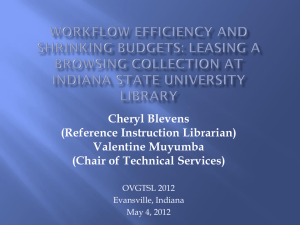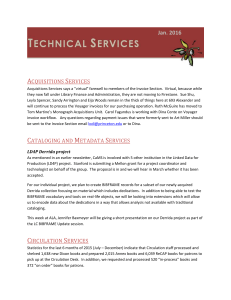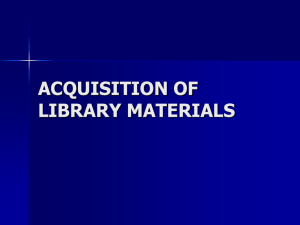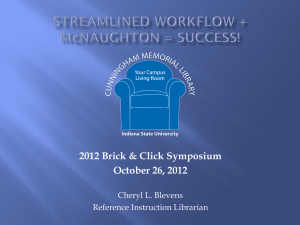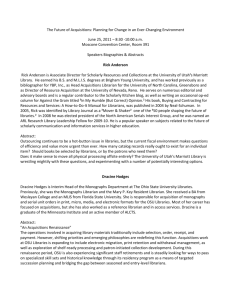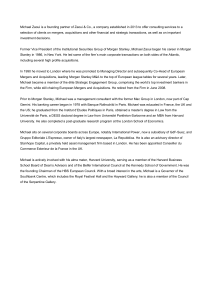christman_marissa_li..
advertisement
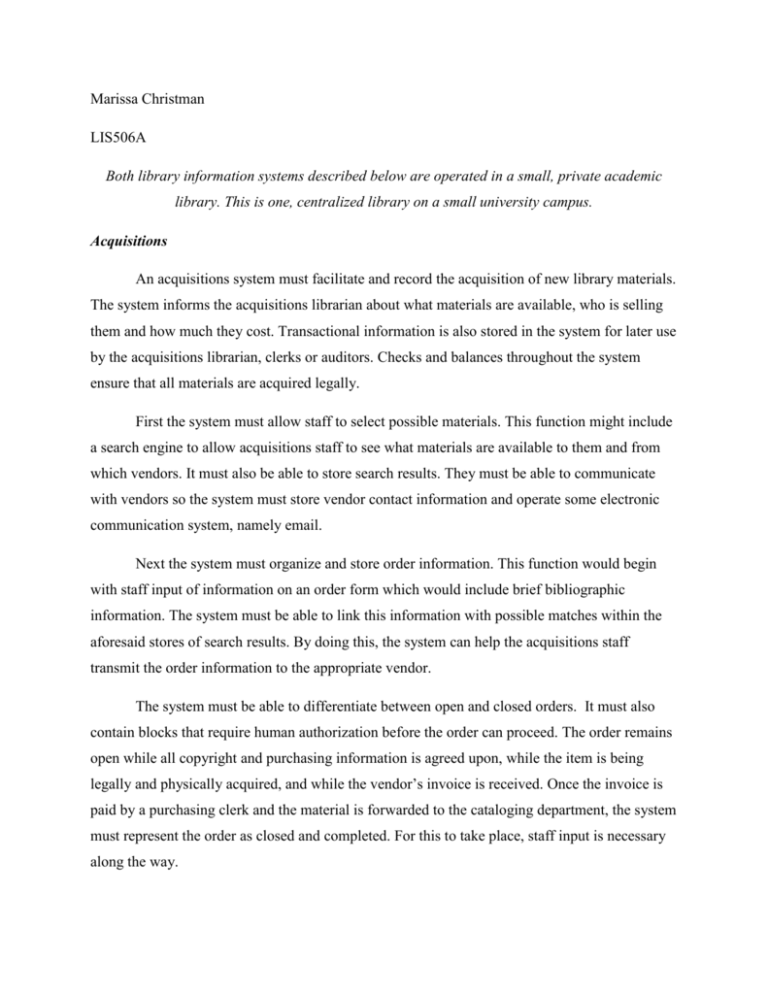
Marissa Christman LIS506A Both library information systems described below are operated in a small, private academic library. This is one, centralized library on a small university campus. Acquisitions An acquisitions system must facilitate and record the acquisition of new library materials. The system informs the acquisitions librarian about what materials are available, who is selling them and how much they cost. Transactional information is also stored in the system for later use by the acquisitions librarian, clerks or auditors. Checks and balances throughout the system ensure that all materials are acquired legally. First the system must allow staff to select possible materials. This function might include a search engine to allow acquisitions staff to see what materials are available to them and from which vendors. It must also be able to store search results. They must be able to communicate with vendors so the system must store vendor contact information and operate some electronic communication system, namely email. Next the system must organize and store order information. This function would begin with staff input of information on an order form which would include brief bibliographic information. The system must be able to link this information with possible matches within the aforesaid stores of search results. By doing this, the system can help the acquisitions staff transmit the order information to the appropriate vendor. The system must be able to differentiate between open and closed orders. It must also contain blocks that require human authorization before the order can proceed. The order remains open while all copyright and purchasing information is agreed upon, while the item is being legally and physically acquired, and while the vendor’s invoice is received. Once the invoice is paid by a purchasing clerk and the material is forwarded to the cataloging department, the system must represent the order as closed and completed. For this to take place, staff input is necessary along the way. Built-in stopping points are a means of verifying the legality of the transaction. Staff will have to input the proof of authorization at various points or else the order will not progresses from open to complete. For example, the staff must notify the system, by way of input, when an order is approved by the acquisitions librarian or when the library receives legal custody of the item. The same goes for the library’s physical receipt of the item. The system should be able to retrieve billing information from the vendor directly via the electronic communication system mentioned above. It will, however, be necessary for staff to input payment information. Upon the input of payment information, the system must close the order and store all information involving to the transaction such as that relating to the vendor, the order, the receipt of material, the payment of vendor invoices and any pertinent legal/ownership information. This acquisitions system is a closed system as far as the library is concerned. It is the only system within the library that is not interconnected to other library systems. The cataloging system may store similar bibliographic information but there is no interplay between the systems while they perform their functions. The cataloging system begins its operations only after the acquisitions system performs its beginning and ending function. The acquisitions systems does not need information from the library’s other systems, though the library’s other systems may need information stored by the acquisitions system. The acquisitions system assembles data from outside agencies (i.e. vendors and publishers), and data input by department staff. One may say that these details imply an open system because the system’s functions are not contained within the library. The system allows the library to communicate with systems at other agencies. Paper documentation is a necessary part of the system as not all functions of acquisitions can be accomplished digitally, such as communication with attorneys, business arrangements with vendors, and budgetary decisions. The library staff is the last but perhaps, most important part of this information system. The digital system requires input from various staff members in the department though the authorization of the acquisition librarian is required at various points throughout the system. Without staff input, the system would not function. The acquisitions system is therefore not just a computer program. The system is the cooperation between the program, the paper documentation and the human input. Circulation A circulations system has the purpose of monitoring library inventory by storing the transactional data that is created when users check books in and out. The system has some secondary purposes in that it tells staff and users an item’s availability status, it creates a digital queue of users for high-demand items, it detects borrowing violations and calculates subsequent fines, and it also allows patrons to request materials remotely. Its main source of data is input by circulation clerks. This data comes from the user’s student card, which retrieves his or her user account. Therefore, this system requires input devices and drivers that recognizes card information and summons user accounts. A server is necessary to store all user account information. It must be big enough to store current and historical transactions as well as user contact information. Additional data would be entered by circulation staff as scanned from the barcode assigned to the library material in question, which retrieves the item’s account. This would be done to check the item in and out. The aforementioned server must also store account information for each library material in circulation. For identification purposes these accounts would contain brief bibliographic data provided by the cataloging system, which is discussed further below. Circulation history must also be recorded and stored in these accounts. The system must also compile and store waiting lists per remote requests, and issue prompts when a wait-list item is checked back into the system. Circulation staff can then keep the item in custody and notify the next user on the list that the item is available. Also, the system records which user is in legal possession of which material and when. The library can hold the appropriate users responsible for extensive damages the material incurs while in his or her possession. It is also necessary for circulation staff to know a material’s status to ensure that all patrons have a fair chance at viewing the material. Prompts would need to be programmed into the system so that circulation staff are made aware of overdue materials. The library may then contact users with overdue materials or fine noncompliant patrons according to the transactional data stored on the server, bringing additional income into the library. If the material is taken out of circulation for repair or as an inter-library loan, the system would need to be able to issue a status update. It would need to be notified via staff input but once the material’s status is changed, it should be able to broadcast the item’s new status to all appropriate parties. This status-broadcasting function should also operate when a book is checked in or out. The system is therefore in need of a digital communication device that allows transmission between the circulation system and other library systems. Users and staff need to be able to ascertain a material’s status in real time via appropriate interfaces and displays. Both reference staff and library users need to be able to retrieve the status of materials they are looking for but they must not have access to private user or material account information. In addition to a display of the item’s status, a user interface must include a means of digitally requesting a material. If an item is already checked-out, patrons would need to be able to add their names to a wait-list. Since users search for library items at workstations and from these results determine what items they want, the functions mentioned above would require that the system be networked with the cataloging system. Circulation staff would be the foremost users of this system but patrons and staff will also, to a lesser extent, make use of the system. The system can be used to determine what books users have checked out in the past and by what users books have historically been checked out. Consequently, the system has long-term value in providing transactional data that can be analyzed to find circulation trends. The system must therefore have a report-generating function that allows it to cumulate all relevant data and organize it into a report that is able to be read and analyzed by library staff. Other librarians may use this information to assess what materials are utilized most and least often by users, allowing them to purge neglected and outdated items. Likewise, the acquisitions librarians might consult reports created by this system in order to assess user needs and desires to inform purchasing. There can be no doubt that the circulations system is an open system because it uses information compiled by other systems when it borrows bibliographic information from the cataloging system. Moreover, it interacts with other library systems as it performs its daily functions by broadcasting status updates and linking to the online catalog used at student workstations. If the cataloging system is malfunctioning, then the circulations system is also at risk. Also indicative of its open-style formatting is its usefulness to other departments. Like the acquisitions system, the circulations system is composed of both digital and personal inter actions that help make the library function.

